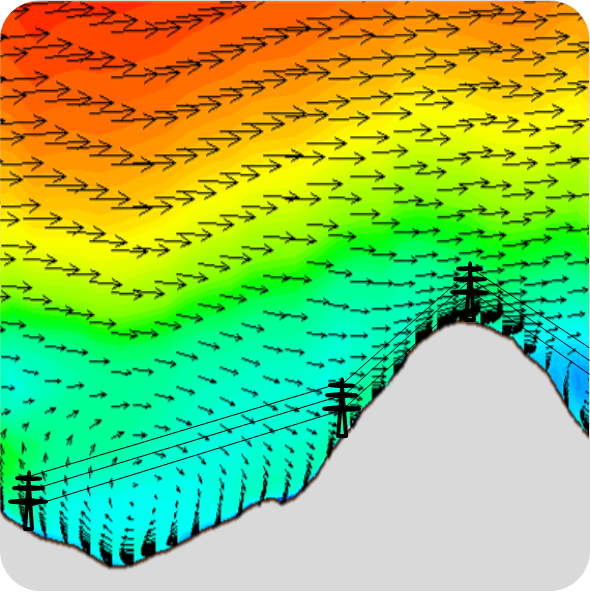Hot Spot Analysis and Monitoring of Overhead Lines
By measuring and monitoring the meteorological parameters wind velocity and direction as well as solar radiation and air temperature, the transmission capacity of overhead lines can be optimised dynamically. Using this procedure measuring sites can be found by identifying bottlenecks of the maximum transmission capacity. Those bottlenecks are called hot spots.

CFD-Windfeldsimulation
- GIS analysis ofheight profiles of overhead lines based on high resoluted terrain data
- Analysis of highly resoluted wind, temperature, and radiation data
- Transfer of the meteorological data to the overhead lines by using a high resolution CFD flow model for complex terrain
- Provision of multi-year meteorological time series in high temporal resolution for all sections of the overhead lines

Hotspotanalyse
- Consideration of the combined technical and meteorological impact
- Analysis of the maximum transmission capacity by using the Cigré model according to the German guideline VDE-AR-N 4210-5
- Determination of the probability of exceeding of the overhead lines' capacity under permanent load
- Identification of local hot spots

Sensitivity analysis
- Sensitivity analysis of the normalised continuous current-carrying capacity by using and iterative buffering model
- Evaluation of the change in the maximum current-carrying capacity by removing single hot spots
- Reduction of measuring sites for each overhead line
Grid calculations and studies

In cooperation with P&M we offer supplementary grid calculations and studies in connection with dynamic overhead line monitoring. P&M has experience of several years in the field of grid calculations in different voltage levels, including the transmission network level.
- Preparation/extension of load flow models for extra high-voltage and high-voltage power systems
- Parameterisation, execution and evaluation of grid calculations in order to solve essential problems in terms of increased transmission capability, particularly in regard of the following issues:
- Guaranteing safe and selective grid protection and avoid hyper-function
- Guaranteing voltage maintainance and stability
- Consideration of n-1 and n-2 cases/li>
- Avoiding re-dispatch measures in connection with increased transmission capability in order to save costss
- Development of approaches for a safe and stable grid operation while using adaptive overhead line monitoring



